Author: Grayscale; Compiler: W3C DAO
Recently, Grayscale released a February report, which pointed out that Bitcoin may hit a new historical high later this year. The following is the full text of the report:
Full text of the report
In February, the price of Bitcoin rose 45%, surpassing $60,000 for the first time since the fourth quarter of 2021, and is only 9% below the historical high.
We believe the price increase may reflect significant inflows into new US-listed ETFs and expectations of the Bitcoin issuance halving in April.

In a mixed month for traditional assets, the cryptocurrency market produced solid returns in February 2024, helped by steady inflows into the new spot Bitcoin ETF and various positive fundamental developments .
Currently, the main risk to digital asset valuations may be the Federal Reserve’s monetary policy: inflation picked up again in February, which could delay interest rate cuts until Later this year or longer.
Both Bitcoin and Ethereum gained in February in both absolute and risk-adjusted terms (returns relative to volatility) One of the best performing assets in cryptocurrencies and traditional finance.
Global bond markets have fallen this month as rising inflation dented hopes of interest rate cuts from the U.S. and European Central Banks. Stocks were mostly higher, led by shares in China and other emerging markets.
Despite cryptocurrencies’ increasing correlation with traditional markets in recent years, the performance of major coins in February once again highlighted crypto assets Category diversification advantage.
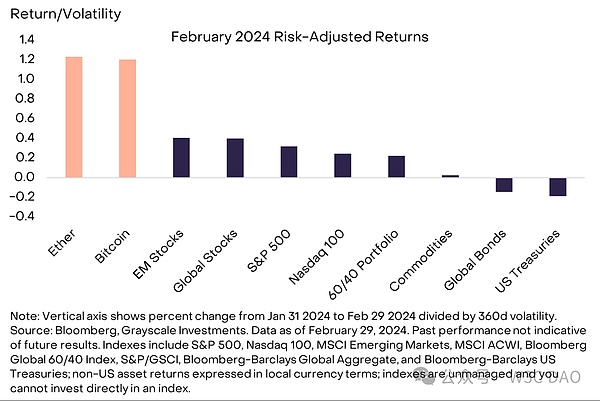
For Bitcoin, the solid returns may reflect, at least in part, steady inflows into the new U.S.-listed spot Bitcoin ETF.
From its launch on January 11 to the end of that month, the 10 spot Bitcoin ETFs had a cumulative net inflow of US$1.46 billion. In February, net inflows accelerated significantly, with net inflows reaching US$6 billion throughout the month. Across crypto exchange-traded products (ETPs), we estimate net inflows totaled $6.2 billion in February, more than double monthly records dating back to October 2021.
It is worth noting that since the launch of the spot Bitcoin ETF, gold ETFs listed in the United States have experienced net outflows, which may indicate that investors have One "store of value" asset turns to another.
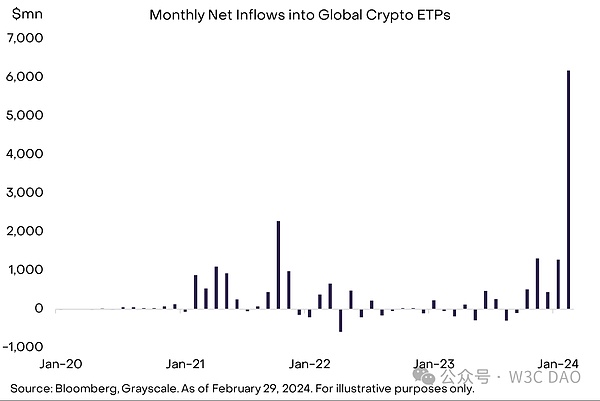
From the perspective of spot Bitcoin ETF inflows, at the current block reward rate, the Bitcoin network will produce about 900 new coins per day, which is about $54 million worth of Bitcoin (assuming every The average coin price is $60,000).
By April 2024, Bitcoin issuance will drop by half - an event scheduled every four years and known as the "halving" - The daily issuance will then drop to 450 Bitcoins, which is approximately $27 million worth of Bitcoins.
In February, net inflows into U.S.-listed spot Bitcoin ETFs averaged $208 million per day, far exceeding the new level even before the halving. The speed of increasing supply. We believe an imbalance between new demand and limited new issuance may have contributed to the increase in valuations.
Although Bitcoin delivered solid returns in February, it was beaten by Ethereum (ETH), the second-largest crypto asset by market capitalization , which rose 47% during the month.
The market appears to be anticipating a key upgrade to the Ethereum network scheduled for March 13. Ethereum is pursuing a modular design philosophy, and over time, more activity will occur on the Layer 2 blockchain connected to the Layer 1 mainnet.
The upcoming upgrade will accommodate this growth by providing Layer 2 with designated storage space on Ethereum, aiming to reduce its data costs, thereby expecting to increase its operating profit. Ethereum may also benefit from other tailwinds, including a focus on "re-collateralization" technology - a leader in the space, Eigenlayer, raised $100 million from venture capital firm a16z this month - and expectations for the future of the ETH Denver conference , and the prospect of regulatory approval for the ETH ETF.
The best-performing segment in February was Utilities and Services Cryptocurrency, up 53%. This product category includes tokens related to artificial intelligence (AI) technologies, some of which have seen huge gains.
Although not originally designed with artificial intelligence applications in mind, we expect Filecoin (FIL) to have benefited from market interest in this topic. The project initially focused on decentralized storage but now includes smart contracts and computing infrastructure, which could lead to synergies with blockchain-based artificial intelligence applications. On February 16, Filecoin announced an integration with Solana to provide a decentralized block history for the network. Filecoin currently holds the dominant market share (~99%) in decentralized data storage.
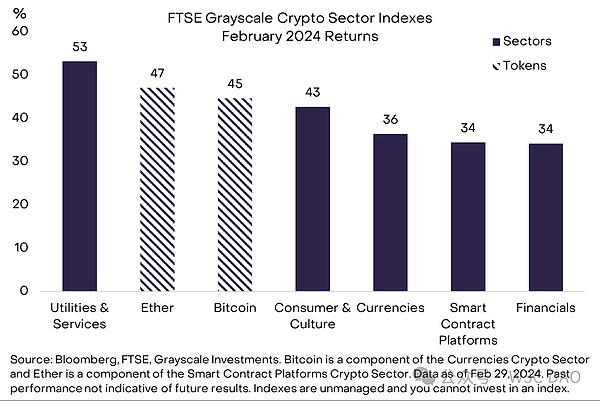
On the other hand, the financial cryptocurrency industry is up 34%. Part of the appreciation is due to the proliferation of governance tokens on decentralized exchange (DEX) Uniswap. The platform generates revenue through transaction fees, a portion of which is transferred to the Uniswap Foundation when users visit the front-end website. However, no revenue currently flows directly to holders of the UNI governance token.
On February 23, the head of governance of the Uniswap Foundation proposed to distribute fee income directly to UNI holders who stake their tokens in platform and delegate voting rights. If implemented, the UNI token will receive a portion of transaction fees from one of the largest decentralized finance applications by transaction volume.
The increase in valuations in February was accompanied by an increase in transaction volume and a rise in various on-chain indicators, especially Ethereum. For example, average daily ETH spot trading volume reached $5.8 billion in February, the highest level since September 2021, according to Coin Metrics data. The value of all transfers on the Ethereum network also increased to its highest level since June 2022.
Finally, the total stablecoin market capitalization increased by another $5.5 billion this month. In related news, stablecoin issuer Circle announced that it will stop supporting USDC on the Tron blockchain. About 80% of USDC in circulation is on the Ethereum network, and only about 1% is on Tron (of which Tether is the mainstablecoin ).
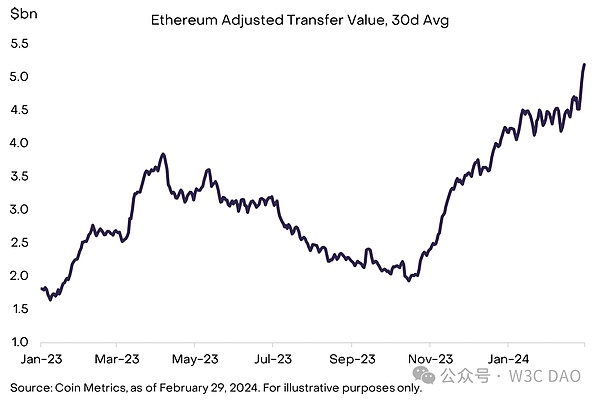
The cryptocurrency market has had a strong year, supported by Bitcoin ETF inflows and various fundamental positives. However, an important lesson from the last crypto cycle is that macro factors such as Federal Reserve monetary policy and economic conditions can significantly impact crypto asset valuations.
If the macro market outlook remains positive, many favorable factors for the industry - including Bitcoin's halving and Ethereum's impending upgrade - could cause token prices to It will rise further this year. Bitcoin’s price is currently just 9% below its all-time high, so a new all-time high is likely to be reached later this year.
In contrast, a less favorable macro outlook could dampen valuations. In the fourth quarter of 2023, Bitcoin may benefit from the Federal Reserve's shift from raising interest rates to cutting interest rates.
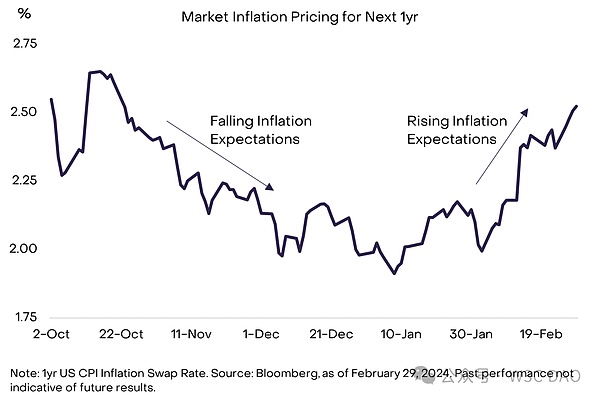
If the central bank does cut interest rates in the coming months, it could weaken the dollar and support the valuations of assets that compete with the greenback, including Bitcoin. But in January, the steady decline in U.S. inflation appeared to be slowing or pausing on some measures, and markets began to turn higher on the inflation outlook. If inflation remains high, Fed officials may consider delaying rate cuts until later this year or into 2025. Generally speaking, rising U.S. interest rates can be positive for the value of the U.S. dollar and negative for Bitcoin.
We believe that the most likely outcome is that U.S. consumer price inflation will continue to decline, prompting the Federal Reserve to eventually cut interest rates. But cryptocurrency investors should keep an eye on the upcoming inflation report and updated policy rate guidance from the Federal Reserve at its next meeting on March 20.
Written at the end
Grayscale releases February market report pointing to Bitcoin price 2 It rose about 45% month-on-month and exceeded $60,000 for the first time since the fourth quarter of 2021.
 Coinlive
Coinlive 
 Coinlive
Coinlive  decrypt
decrypt Others
Others Bitcoinist
Bitcoinist Bitcoinist
Bitcoinist Bitcoinist
Bitcoinist Cointelegraph
Cointelegraph Cointelegraph
Cointelegraph Cointelegraph
Cointelegraph Cointelegraph
Cointelegraph